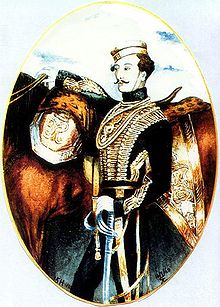Louis Edward Nolan
| Louis Nolan | |
|---|---|
 |
|
| Born |
4 January 1818 York County, Upper Canada |
| Died | 25 October 1854 (aged 36) Crimea, Russia |
| Allegiance |
|
| Service/branch |
|
| Rank | Captain |
| Battles/wars | Crimean War |
Louis Edward Nolan (4 January 1818 – 25 October 1854) was a British Army officer and cavalry tactician best known for his role and death in the Charge of the Light Brigade during the Crimean War. Born to a minor diplomatic official and his wife, Nolan was educated at the Austrian Inhaber Pioneer School at Tulln, where he was noted as an enthusiastic horseman and military theorist. After early graduation he was commissioned as a subaltern in the 10th Austrian Hussar regiment, serving in Austria, Hungary and on the Polish frontier, where he again became known for his horsemanship and was promoted to senior lieutenant. Due to the nepotism inherent in the Austro-Hungarian armed forces, Nolan succeeded in transferring to the British Army as a Cornet in the 15th Light Dragoons.
Deployed in India, Nolan was eventually made the regimental riding master and an aide-de-camp to General George Berkeley, commander-in-chief in Madras, accompanying him on horse trials to evaluate the use of geldings as cavalry mounts rather than stallions, and was made a Captain in 1850. Returning to Great Britain in 1851, he toured continental Europe and wrote two books on horsemanship and cavalry theory, the second of which, Cavalry: Its History and Tactics, was universally acclaimed and led to the adoption of a Nolan-designed saddle by the British Army. A trusted voice on cavalry matters, Nolan was dispatched to the Middle East in the early days of the Crimean War to hunt for appropriate mounts. After returning he was attached to the staff of General Richard Airey, and in this role delivered the order that led to the Charge of the Light Brigade.
40 percent of the Light Brigade's soldiers were killed, wounded, captured or rendered unfit for service, including Nolan, who was the first casualty of the Charge. Contemporary accounts blamed Nolan for failing to properly communicate the order, either accidentally or deliberately, while some modern historians apportion the blame not only to Nolan but also Lord Raglan, commander of the British forces in the Crimea, and the cavalry commander Lord Lucan.
...
Wikipedia
